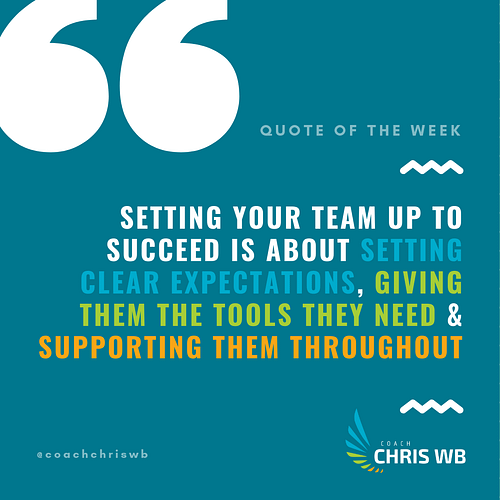In a previous post titled “how to set your team up for success” I talked about your responsibility, as a leader, to set your team(s) up for success. In this article, we will discuss what is next and what you should do if your team still is underperforming.

Observe, measure & keep measuring
Observation & measurement are both important aspects of leadership. You should be observing team behaviours, body language and other factors such as attendance. These are likely to be indicators of team health and satisfaction, and where issues are identified you should take the initiative to engage and seek feedback from your team members.
SMART Objectives
Smart objectives or targets with “smart criteria” are important because they are proven to improve personal and team performance because they are easier to understand and to know when they have been done. The acronym represents targets & objectives that are;
- Specific – target a specific area for improvement.
- Measurable – quantify or at least suggest an indicator of progress.
- Assignable – specify who will do it.
- Realistic – state what results can realistically be achieved, given available resources.
- Time-related – specify when the result(s) can be achieved.
Be consistent
Creating and maintaining highly effective teams is not a short-term, once off initiative. You need to define your approaches and be consistent across your organisation. Nobody should be exempt from your initiative and organisational values, from CEO down, every body should be held to the same standards and nobody is excluded from being called out for failure to adhere with agreed organisational norms, nobody!
Identify if it is a team or individual team members issue
The first step is to identify where the issue really is in the business and we can do that by asking some pretty simple questions;
- Is the issue related to the team, their dynamics or group norms?
- Are the results from the team overall below your stated expectations?
- Do the group norms not align with your organisational values?
If you answer yes to any of the above then the issue is related to the team itself, and you must then reflect further on your own leadership (re-read my previous post?) and look to implement initiatives that are designed to change the team culture… read on!
So it is a team issue?
Break the cycle
Sometimes the answer is a simple one, quite often it is a matter of understanding why they are not motivated or how they feel about themselves, the team and the organisation. An open conversation about these types of things may give you the insights you need to positively shift the teams’ attention and focus to be aligned with your expectations. Further, it may give you honest feedback about how realistic your expectations actually are.
Some suggestions include;
- Team discussions – present expectations vs actual outcomes and ask them, in a constructive way what you can do as their leader to help them succeed
- Thorough, constructive retrospectives – again this comes down to the presentation of results to the team and open discussions about how to improve
- Restate expectations clearly – sometimes a reset, as in, forget the past, let us start again based on new rules of engagement is important
- Individual discussions – pull each team member aside in an informal setting (over coffee?) and talk to them about the team and their own performance, again the emphasis here should be what they need from you to succeed
Implement change
If after trying to break the cycle your team is still not delivering, it is time to force a shift by implementing change. At this stage, we’re still talking about team or organisational level change though as it is not yet clear that it is an individual team member issue.
You can implement change in too many ways for me to cover in this article but some examples include;
- Trigger a reset the stages of team or group development – add a team member (who you know to be a positive, energetic and influential person within the organisation (or hire specifically for this purpose)
- Review and implement process changes – look at how people are working to determine if a change would influence the team positively e.g. implement agile or 360° feedback
- Make your SMART objective reporting public – look to show scorecards and leaderboards to promote positive behaviours and working habits
- Provide additional training – consider soft-skill training like Leadership or Productivity Hacks (both of which I offer through my engagements)
At this point, if the team is still not performing and you truly believe you have set them up to succeed it is time to start considering that it is an issue with individual team members (and their potential effects on those around them).
So it is an individual team members issue?
Is their role right?
The first thing you should check when starting to evaluate an individuals impact on team performance is whether they are actually doing the role that they agreed to when joining the team. Just because there is a need for a shift in role for an individual to meet business requirements, does not mean that every team member will be happy with that change. In fact the best team members are those who will work with you on these types of needs, however, everybody has their limits.
When I conduct exit interviews there are two common themes, especially with technical roles;
- I want to use newer (read: higher value) technology and/or methodologies
- I want to take on new challenges
While it is not always possible for every team member to be hired for and use the newest products, technologies or methodologies, I see many organisations hiring for the newest, but actually having their teams using the oldest.
If you are in the process of transitioning from an old tech/methodology then communicate that upfront and ensure there is a roadmap to get there that individuals will be involved in. If you are hiring for maintenance of a legacy product, state that upfront so there are no nasty surprises.
If you identify team members in this position, try to identify more appropriate projects or teams for them to be a part of. Otherwise, be direct about the future of their role and let them make the choice about their continued involvement in the team.
Encourage higher volumes of feedback
Feedback is the key to learning and development and as such, it is important to build a culture that encourages feedback across teams and the organisation. An annual performance review is the most common form of feedback but it lacks the context and frequency to drive continuous improvement across your organisation.
Some approaches to explore for your team include;
- Development planning – all resources should have some form of a development plan in place. These should contain; future career direction, educational/training requirements, key performance indicators and goals
- Monthly informal catch-ups – grab a coffee with your team members and ask them how they’re going. Come prepared with information and statistics about their individual performance but this should not necessarily be the focus of these discussions. Take the time to understand what other factors may be impacting their performance; their personal lives, their personal goals and ambitions, their health and fitness. Don’t do it in a creepy way of course but these are all factors that will influence them and their working life. You should also take this time to review how they are going with their development plan and what help they may require from you to ensure they succeed
- Implement 360° feedback – this approach is particularly useful because the core principle is that performance data is captured by those closest to the person being evaluated. That is that each team member is evaluated against common metrics by their manager, their team members and importantly themselves. This type of feedback method has great value but can take significant time to set up and implement.
Still not working?
If after all of this your team is not performing then, as a leader, it is time to start making hard decisions. You need to recognise that your responsibility is ultimately to the organisation and the teams, not the individuals. If there are toxic personalities and team members, then it is your responsibility to manage them out of the business.
I see many executives maintain relationships with team members who are not performing to expectations because of a sense of responsibility to “do right by them”, and while that is admirable, I would always challenge them to focus that energy on those who are “doing right by the organisation”.
This is obviously a really hard topic but if you have gone through the steps in my previous post and then this one too, and you have team members who are still not performing, then I believe you can hand on heart state that you have really set them up to succeed and tried multiple approaches to correct their behaviour and performance, and it is probably best for all parties to move on from the engagement.
Do not forget that “often the hardest decisions are the most important to the success of your organisation”, unfortunately, leadership is not all fun and games, kicking goals or realising your vision for your team and organisation.

